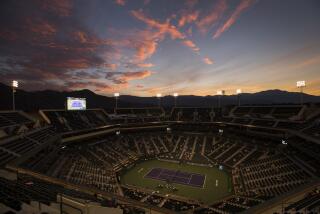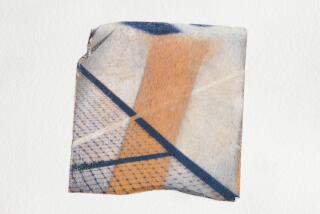They get back to the glorious grind
FROM NEW YORK — The grunt and groan begins today. This is U.S. Open tennis time.
There are four majors on the tour each year. Each is called a Grand Slam. The players live for them and refer to them merely as “Slams.” The people who run them, tennis federations in Australia, France, England and the United States, quietly refer to them with sounds resembling the ringing of cash registers.
Australia is the hang-loose friendly major. The French is delightful on clay and delectable in cuisine. Wimbledon is grassy and brassy in a British stiff-upper-lip way.
Then there is the U.S. Open, the annual grand-and-grind finale of a long season, one that pounds the minds and bodies of the greatest tennis players in the world into semi-mush. When the players arrive here, they have been nicely numbed by hundreds of thousands of forehands and backhands and serves. Their minds have followed the bouncing ball into some sort of catatonic happy place.
There is no truth to the theory that the concept of ending the season of majors with the U.S. Open is a plan once presented to tennis by the Marquis de Sade. The torture is only coincidental to the late-season landing spot in the schedule.
The U.S. Open is an echo of the city where it lives. If you can win it here, you can win it anywhere. Of the four majors, the U.S, Open is the one with a chip on its shoulder.
That, of course, makes it even more appealing to many.
The next two weeks will present the players with noise, heat and humidity. It will bring out crowds who appreciate tennis and crowds who think this is like a Mets game. Bright and sunny days will be followed by days of swirling wind and disruptive rain. There will be the rumble of the No. 7 train and the occasional shriek of an airplane that hasn’t gotten the memo about not flying directly overhead en route to or from nearby Kennedy or LaGuardia.
The main stadium, named for former star and humanitarian Arthur Ashe, seats 23,763. The old main stadium, named for musician Louie Armstrong, has been cut down to 10,123. Its adjoining grandstand seats 6,106. In 26 sessions last year, as an economy was crumbling, the U.S. Open drew 720,227 and loves to tout itself as the best-attended annual sports event in the world.
If you want to buy a couple of tickets on Ticketmaster right now for the men’s final -- assuming your company hasn’t purchased one of the luxury suites that would make your ticket priceless -- you can plunk down $1,600. Heck, the kids don’t need new shoes for school this year, anyway.
The story lines will include:
* A revitalized Roger Federer attempting to increase his record of major victories to 16 and attempting to win his sixth straight title here.
* The return of Federer-killer Rafael Nadal from a spring and summer of sore knees that not only cost him his fifth straight French title, but dropped his ranking to No. 3, behind Federer and Britain’s Andy Murray.
* The title defense of Serena Williams and a possible semifinal challenge from her sister Venus. Since 1999, the two have won five of the ten U.S. Open titles, Serena winning three.
* The emergence of young Californian Sam Querrey as a challenge to top U.S. men’s star Andy Roddick, and the prospect of Roddick regaining the magnificent form that allowed him to fight Federer to the brink before losing in the Wimbledon final.
* And the return of Belgium’s Kim Clijsters, from retirement and motherhood, for a shot at adding to the 2005 title she won here.
Sunday was a day of practice and socializing at the Billie Jean King USTA Tennis Center.
Federer, resplendent in black and red, was spotted in the distance by a gathering of female teenage autograph seekers, who gushed, almost in unison, “Oh, my God.”
Nadal met the press and answered just about every question about his current physical condition with the phrase “I am perfect.”
Querrey, who lost in the final in New Haven on Saturday night and who has won 19 of his last 26 matches, met the press and said, “I’m excited and ready to go.”
And new mom Clijsters, one of the more popular players, played high-five with a 6-year-old in the players’ lounge while other players on both tours waited in line for welcome-back hugs.
It was the quiet before the storm. And the storm that will blow through here in the next two weeks will bring upsets, temper tantrums, five-hour matches and wild scenes under the lights in front of some of New York’s finest drunks. Players will hit aces and smash rackets. Crowds will consume enough fast food to create a regional heartburn epidemic. Careers will be made, others ended.
And somewhere, in the middle of all this, something more amazing than usual will happen, sparking a left-handed guy with an Irish name and four U.S. Open titles to his credit to stand up in a broadcast booth, survey the scene and speak the words that best befit this annual sports carnival:
“You cannot be serious,” he will say.
--
More to Read
Go beyond the scoreboard
Get the latest on L.A.'s teams in the daily Sports Report newsletter.
You may occasionally receive promotional content from the Los Angeles Times.











